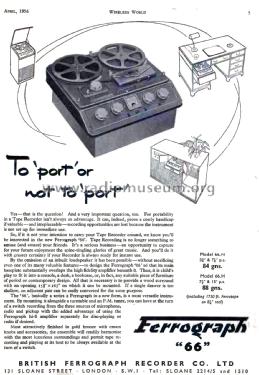- Country
- Great Britain (UK)
- Manufacturer / Brand
- Ferrograph, British Ferrograph Recorder (Wright & Weaire); London
- Year
- 1956 ?
- Category
- Sound/Video Recorder and/or Player
- Radiomuseum.org ID
- 343064
- Main principle
- Audio-Amplification
- Wave bands
- - without
- Details
- Tape Recorder
- Power type and voltage
- Alternating Current supply (AC) / 220-240 Volt
- Loudspeaker
- - For headphones or amp.
- Material
- Various materials
- from Radiomuseum.org
- Model: 66H - Ferrograph, British Ferrograph
- Shape
- Tablemodel, with any shape - general.
- Dimensions (WHD)
- 438 x 108 x 438 mm / 17.2 x 4.3 x 17.2 inch
- Notes
-
Two Speed Tape recorder model Ferrograph 66H
To ‘port or not to ‘port’
Yes, that is the question! And a very important question, too. Portability in a Tape Recorder isn't always an advantage. It can, indeed, prove a costly handicap if valuable and irreplaceable recording opportunities are lost because the instrument is not set up for immediate use. So, if it is not your intention to carry your Tape Recorder around, we know you'll be interested in the new Ferrograph '66'.
Tape Recording is no longer something to amuse (and amaze) your friends. It's a serious business-an opportunity to capture for your future enjoyment the spine-tingling glories of great music. And you'll do it with greater certainty if your Recorder is always ready for instant use.
By the omission of an inbuilt loudspeaker, it has been possible-without sacrificing even one of its many valuable features to design the Ferrograph '66' so that its main baseplate substantially overlaps the high-fidelity amplifier beneath it. Thus, it is child's play to fit it into a console, a desk, a bookcase, or, in fact, any suitable piece of furniture of period or contemporary design. All that is necessary is to provide a wood surround 15 ⅜" X 16½ on which it can be mounted.
If a single drawer is too shallow, an adjacent pair can be easily converted for the same purpose.The `66', basically a Series 2 Ferrograph in a new form, is a most versatile instrument.
By mounting it alongside a turntable and an F.M. tuner, you can have at the turn on of a switch recording from the three sources of microphone, radio, and pickup with the added advantage of using the Ferrograph hi-fi amplifier separately for disc-playing or radio if desired.
Most attractively finished in gold bronze with cream knobs and accessories, the ensemble will readily harmonise with the most luxurious surroundings and permit tape recording and playing at its best to be always available at the turn of a switch.
Features:
- Three independent motors
- Synchronous capstan drive
- Recording level meter
- Large 8¼ inch diameter spools could be used, allowing up to 68 minutes of playing time at 7½ ips.
- One-Knob control
- Two speeds 7½ and 15 ips with Lever change
- Bass and Treble Cuts
- Automatic motor cut-off
See also Ferrograph 66N (3¾ and 7½ ips)
- Net weight (2.2 lb = 1 kg)
- 20.450 kg / 45 lb 0.7 oz (45.044 lb)
- Price in first year of sale
- 88.00 GNS
- Mentioned in
- Wireless World (The), London (WW, 79) (January 1957 page 5)
- Literature/Schematics (1)
- Wireless World (The), London (WW, 79) (Apr 1956, page 5)
- Author
- Model page created by Franz Scharner. See "Data change" for further contributors.
- Other Models
-
Here you find 21 models, 18 with images and 8 with schematics for wireless sets etc. In French: TSF for Télégraphie sans fil.
All listed radios etc. from Ferrograph, British Ferrograph Recorder (Wright & Weaire); London

